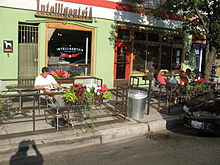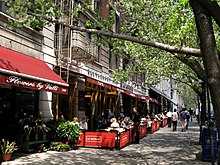Sidewalk cafe
The examples and perspective in this article may not represent a worldwide view of the subject. (September 2019) |

- For the music venue in New York City, see SideWalk Cafe.
A sidewalk cafe or pavement cafe is "a portion of an eating or drinking place, located on a public sidewalk, that provides waiter or waitress service" (as defined by the American Planning Association based upon the New York City planning regulations); the area used solely for dining.[1] Sidewalk cafes are of two types: enclosed and unenclosed, the former being surrounded by a 1-story structure and the latter being an area of the sidewalk that contains removable tables, chairs, and railings.[1]
Sidewalk cafes are common across Europe, forming an important part of street life in countries such as France and Italy.[2]

New York City

New York City regulations control in what areas sidewalk cafes can exist, their construction, and what parts of a sidewalk they can occupy.[3] Proprietors pay a licence fee, which is effectively rent paid to the city for the use of the sidewalk.[4]
From 1988 these regulations were a zoning resolution of the city's Department of Planning.[3] The 1988 resolution prohibited sidewalk cafes in residential areas and on major thoroughfares, permitting them in malls and (conditionally) "in Historic Districts or in designated Landmark Buildings".[3] The stated purposes of the planning regulations are to balance the cafe proprietors' interests against the needs of pedestrians; to conserve the value of land; and to preserve the characters of neighbourhoods.[3]
Up until 2003 the process for obtaining a licence for a sidewalk cafe involved so many city agencies and such a long wait time that the law was regularly flouted, with restaurateurs considering it cheaper to just erect sidewalk cafes and pay the fines after the fact.[4] New approval processes were adopted in that year, reducing the length of the process to 140 days and making it the sole responsibility of the city's Department of Consumer Affairs.[4]
References
- ^ a b Dolnick & Davidson 1999, p. 200.
- ^ Hayward, Tim (6 July 2009). "Dining out, out". The Guardian.
- ^ a b c d Gumpert & Drucker 2017, p. 445.
- ^ a b c Berg 2007, p. 30.
Sources
- Berg, Bruce F. (2007). New York City Politics: Governing Gotham. Rutgers University Press. ISBN 9780813543895.
{{cite book}}: Invalid|ref=harv(help) - Dolnick, Fay; Davidson, Michael, eds. (1999). "sidewalk cafe". A Glossary of zoning, development, and planning terms. American Planning Association.
{{cite encyclopedia}}: Invalid|ref=harv(help) - Gumpert, Gary; Drucker, Susan J. (2017). "Media development and public space: the legislating of social interaction". In Ruben, Brent D. (ed.). Between Communication and Information. Routledge. ISBN 9781351294713.
{{cite book}}: Invalid|ref=harv(help)
Further reading
- Ramati, Raquel. How to Save Your Own Street, Dolphin Books, 1981
- Brown, Carolyn (February 1980). "Sidewalk Cafes". Planning Advisory Service Memos. American Planning Association. pp. 80–2 et seq.
{{cite book}}: Invalid|ref=harv(help)
